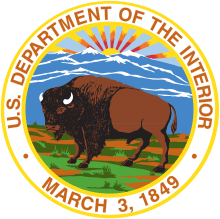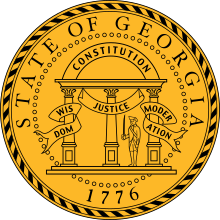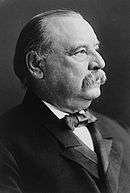M. Hoke Smith
Michael Hoke Smith (September 2, 1855 – November 27, 1931) was an American attorney, politician, and newspaper owner who served as United States Secretary of the Interior (1893–1896), 58th Governor of Georgia (1907–1909, 1911), and a United States Senator (1911–1920) from Georgia.
Hoke Smith | |
|---|---|
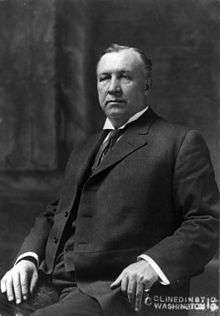 | |
| United States senator from Georgia | |
| In office November 16, 1911 – March 4, 1921 | |
| Preceded by | Joseph M. Terrell |
| Succeeded by | Thomas E. Watson |
| 58th Governor of Georgia | |
| In office July 1, 1911 – November 16, 1911 | |
| Preceded by | Joseph Brown |
| Succeeded by | John M. Slaton |
| In office June 29, 1907 – June 26, 1909 | |
| Preceded by | Joseph M. Terrell |
| Succeeded by | Joseph Brown |
| 19th United States Secretary of the Interior | |
| In office March 6, 1893 – September 1, 1896 | |
| President | Grover Cleveland |
| Preceded by | John Willock Noble |
| Succeeded by | David R. Francis |
| Personal details | |
| Born | Michael Hoke Smith September 2, 1855 Newton, North Carolina, U.S. |
| Died | November 27, 1931 (aged 76) Atlanta, Georgia, U.S. |
| Political party | Democratic |
| Spouse(s) | Birdie Cobb |
Biography
Early years and education
Smith was born in Newton, North Carolina on September 2, 1855 to Hildreth H. Smith, president of Catawba College, and Mary Brent Hoke.[1] When Smith was 2 years old, his father accepted a position on the faculty of the University of North Carolina, and moved the family to Chapel Hill. Smith attended Pleasant Retreat Academy and was primarily educated by his father. Smith was too young to participate in the Civil War, but his uncle, Confederate General Robert Hoke, fought in the war. In 1868, when the elder Smith lost his position at the University, he moved the family to Atlanta, Georgia, the city that would remain the younger Smith's home for the rest of his life.[1] Smith did not attend law school, but read for the law in association with an Atlanta law firm. He passed the bar examination in 1873, at age seventeen, and became a lawyer in Atlanta.[1]
Law practice
Smith maintained a small office in the James building downtown. His practice began to grow when he began to argue injury suits.[2] As his practice grew, he brought in his brother Burton in 1882, also excellent in front of juries, and they worked together for over 10 years.[3] Their main clients were the many railroad workers injured on the job; three-quarters of the cases they took involved personal injury and they won the bulk of them.[4]
Political service

Smith served as chairman of the Fulton County and State Democratic Conventions and was president of the Atlanta Board of Education. In 1887, Smith bought the Atlanta Journal. His strong support in the Journal for Grover Cleveland during the 1892 Presidential election garnered Cleveland's attention and led to a federal job.
Smith was appointed as Secretary of the Interior by Cleveland in 1893.[5] He worked hard to right land patents previously obtained by the railroads, for rationalization of Indian affairs and for the economic development of the South. A staunch defender of Cleveland and his sound money policy, Smith campaigned throughout the country in 1896 for Cleveland candidates.[6] When William Jennings Bryan was selected at the 1896 Democratic National Convention, Smith was in a quandary: could he support the party without supporting the platform? The overwhelming support for silver and Bryan in his home state of Georgia convinced him to try to have it both ways. His newspaper, the Journal, endorsed the candidate but continued to denounce the silver policy. Smith resigned his cabinet post to protect Cleveland.[7]
Smith returned to Atlanta and resumed his lucrative law practice netting around $25,000 per year and slowly rebuilt his local reputation.[8] In April 1900 he sold his interests in the Journal and tried many other investments but the only ones that did well were real estate in the Atlanta area. He was instrumental in organizing the North Avenue Presbyterian Church (which still stands) and was re-elected to the Atlanta Board of Education.[9]
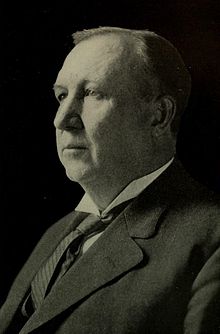
Smith allied himself with Bryan's Vice Presidential candidate, Populist Tom Watson, one of Georgia's most influential politicians. With Watson's support, Smith was elected governor in 1907. In order to gain Watson's support, however, he had to call the Negro vote "ignorant [and] purchasable." Smith established several Jim Crow laws requiring literacy tests and property ownership for voting; "Smith kept his promise to Watson by leading the adoption of a constitutional amendment to impose a grandfather clause that effectively disenfranchised black Georgians."[1] Smith also supported railroad reform and election reform. After losing the support of Watson,[10] he was defeated in the next election by Joseph M. Brown. Smith was re-elected as governor in 1911.
In 1911 while still governor, he was chosen by the Georgia General Assembly to fill out the term of United States Senator Alexander S. Clay. Smith won re-election in 1914, but was defeated by Tom Watson in 1920. Afterward, Smith practiced law in Washington, DC, and Atlanta.
Death and legacy
Michael Hoke Smith died in 1931 and is buried in Oakland Cemetery in Atlanta, the last surviving member of the Cleveland Cabinet.
Smith was a maternal great-uncle of the Louisiana politician Frank Burton Ellis of New Orleans. Hoke Smith High School (1947–1985) once stood at 535 Hill Street SE, in Atlanta. During World War II, a Liberty ship was named the SS Hoke Smith.[11] The Hoke Smith Annex Building on the campus of the University of Georgia was named in honor of the late senator.[12]
References
| Wikimedia Commons has media related to Hoke Smith. |
- Duncan Maysilles (July 19, 2017). "Hoke Smith (1855-1931)". New Georgia Encyclopedia. Retrieved April 25, 2019.
- Dewey W. Grantham (1 March 1967). Hoke Smith and the Politics of the New South. LSU Press. p. 16. ISBN 978-0-8071-0118-6.
- Grantham, p.17
- Grantham, p.21
- Grantham, Dewey W. (November 1949). "Hoke Smith: Progressive Governor of Georgia, 1907-1909". The Journal of Southern History. 15 (4): 423–440. doi:10.2307/2198381. JSTOR 2198381.
- Vinson, John Chalmers; Montgomery, Horace (2010). Georgians in profile : historical essays in honor of Ellis Merton Coulter (PDF). Athens: University of Georgia Press. p. 310. ISBN 978-0820335476. Retrieved 20 June 2016.
- Grantham, p.110
- Grantham, p.113
- Grantham, p.118
- Smith, Zachary (2012). "Tom Watson and Resistance to Federal War Policies in Georgia during World War I". Journal of Southern History. 78 (2): 301. Retrieved 20 June 2016.
- Kenneth Rogers Photographs. "Launch of the SS Hoke Smith". Atlanta History Center - Digital Library of Georgia. Retrieved April 25, 2019.
- "Hoke Smith Annex". University of Georgia. Retrieved 19 June 2016.
External links
- Vanishing Georgia - Photograph of a political rally for the gubernatorial race of 1906, Fitzgerald, Ben Hill County, Georgia, 1906
- United States Congress. "M. Hoke Smith (id: S000551)". Biographical Directory of the United States Congress.
- The Strange Career of Jim Crow by C. Vann Woodward, 2nd edition, (Oxford University Press: 1966) pp. 86–91.
| Political offices | ||
|---|---|---|
| Preceded by John Willock Noble |
United States Secretary of the Interior 1893–1896 |
Succeeded by David R. Francis |
| Preceded by Joseph M. Terrell |
Governor of Georgia 1907–1909 |
Succeeded by Joseph Brown |
| Preceded by Joseph Brown |
Governor of Georgia 1911 |
Succeeded by John M. Slaton |
| Party political offices | ||
| Preceded by Joseph M. Terrell |
Democratic nominee for Governor of Georgia 1906 |
Succeeded by Joseph Brown |
| Preceded by Joseph Brown |
Democratic nominee for Governor of Georgia 1910 | |
| First | Democratic nominee for U.S. Senator from Georgia (Class 3) 1914 |
Succeeded by Thomas E. Watson |
| U.S. Senate | ||
| Preceded by Joseph M. Terrell |
U.S. Senator (Class 3) from Georgia 1911–1921 Served alongside: Augustus Bacon, William West, Thomas W. Hardwick, William J. Harris |
Succeeded by Thomas E. Watson |
| Preceded by William Borah |
Chair of the Senate Education Committee 1913–1919 |
Succeeded by William Kenyon |
